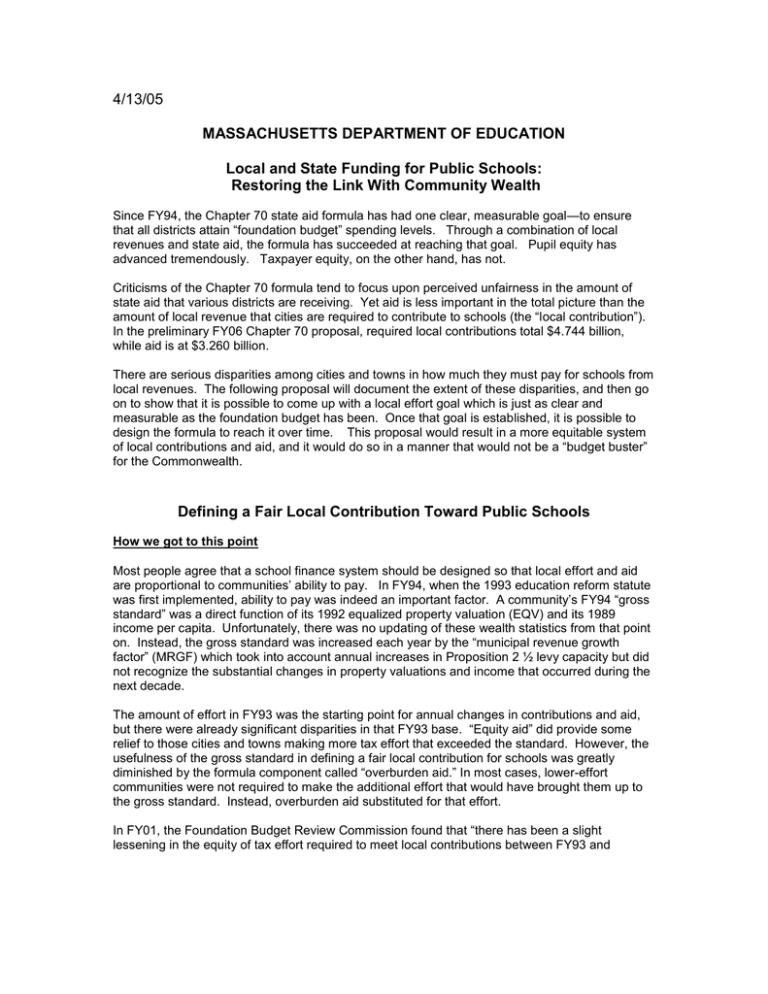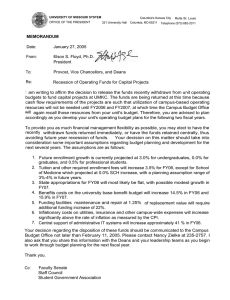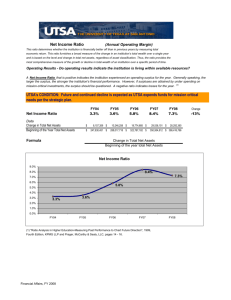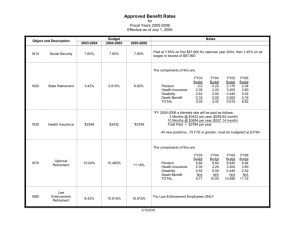formula05 1
advertisement

4/13/05 MASSACHUSETTS DEPARTMENT OF EDUCATION Local and State Funding for Public Schools: Restoring the Link With Community Wealth Since FY94, the Chapter 70 state aid formula has had one clear, measurable goal—to ensure that all districts attain “foundation budget” spending levels. Through a combination of local revenues and state aid, the formula has succeeded at reaching that goal. Pupil equity has advanced tremendously. Taxpayer equity, on the other hand, has not. Criticisms of the Chapter 70 formula tend to focus upon perceived unfairness in the amount of state aid that various districts are receiving. Yet aid is less important in the total picture than the amount of local revenue that cities are required to contribute to schools (the “local contribution”). In the preliminary FY06 Chapter 70 proposal, required local contributions total $4.744 billion, while aid is at $3.260 billion. There are serious disparities among cities and towns in how much they must pay for schools from local revenues. The following proposal will document the extent of these disparities, and then go on to show that it is possible to come up with a local effort goal which is just as clear and measurable as the foundation budget has been. Once that goal is established, it is possible to design the formula to reach it over time. This proposal would result in a more equitable system of local contributions and aid, and it would do so in a manner that would not be a “budget buster” for the Commonwealth. Defining a Fair Local Contribution Toward Public Schools How we got to this point Most people agree that a school finance system should be designed so that local effort and aid are proportional to communities’ ability to pay. In FY94, when the 1993 education reform statute was first implemented, ability to pay was indeed an important factor. A community’s FY94 “gross standard” was a direct function of its 1992 equalized property valuation (EQV) and its 1989 income per capita. Unfortunately, there was no updating of these wealth statistics from that point on. Instead, the gross standard was increased each year by the “municipal revenue growth factor” (MRGF) which took into account annual increases in Proposition 2 ½ levy capacity but did not recognize the substantial changes in property valuations and income that occurred during the next decade. The amount of effort in FY93 was the starting point for annual changes in contributions and aid, but there were already significant disparities in that FY93 base. “Equity aid” did provide some relief to those cities and towns making more tax effort that exceeded the standard. However, the usefulness of the gross standard in defining a fair local contribution for schools was greatly diminished by the formula component called “overburden aid.” In most cases, lower-effort communities were not required to make the additional effort that would have brought them up to the gross standard. Instead, overburden aid substituted for that effort. In FY01, the Foundation Budget Review Commission found that “there has been a slight lessening in the equity of tax effort required to meet local contributions between FY93 and 2 FY01.”1 In subsequent years, the statutory formula has been replaced by a series of formulae authorized in annual state budget language. Those used in FY02 and FY03 did contain provisions to improve the fairness of the contributions, including the use of current property valuations and income. However, in the years since, contributions have been increased by each city and town’s MRGF, with no reference whatsoever to its relative property value or income. It is common to hear Chapter 70 described as a “wealth-based” formula, but that is not the case at the current time. Measuring ability to pay A basic issue in measuring ability to pay is whether to use property value or income, or both. Property valuation identifies a community’s “stock” of wealth, and income measures its “flow” of wealth. Both are valid measures, and a combination of the two makes good sense. Doing so allows the formula to distinguish between the separate amounts of wealth held by two different but overlapping populations. Using income recognizes the relative burden imposed on residents when they pay their local tax bills and fees. Using valuation recognizes that in most cities and towns both residents and non-residents tend to own property and that the non-residents should share in the cost of providing services. Equalized property valuation is a statistic calculated by the Massachusetts Department of Revenue (DOR) every two years. It adjusts for the fact that the Commonwealth’s 351 cities and towns are on a staggered three-year revaluation schedule, by raising or lowering each community’s valuations to reflect the most recent ratios of sales prices to assessed values. It is widely accepted and has been a staple feature of Massachusetts state aid formulas for decades. Municipal Income is derived annually by DOR from Massachusetts state income tax returns. As currently compiled, it includes all forms of wage, pension, interest, business, investment, and capital gains income. It does not reflect the earnings of non-filers, but the reason most people do not file is because their income is below the minimum filing level, so excluding these residents should not significantly underestimate the aggregate amount of income in a city or town. In 2002, 5.7 million of the state’s estimated 6.4 million residents were represented on state tax returns. Over the decades, the most common approach taken by Massachusetts state aid formulas has been to divide either equalized property valuation or some form of income by a denominator such as enrollment or population. Some of these measures, while statistically valid, have been complicated and therefore difficult to explain. The more difficult the calculations are, the harder it is to convince the public that the system is fair. We should strive to keep the definition of ability to pay as straightforward as possible. One way of simplifying the calculation is to avoid the use of denominators entirely. A town’s ”aggregate wealth” can be defined as the composite of its total equalized property valuation and its total annual income. Its local effort can be defined as the percentage of either of these two measures represented by its local contribution to schools. For local effort to be directly proportional to ability to pay, all municipalities should pay the same percentage. Current levels of effort On the average, the required local contributions calculated by DOE for the preliminary FY06 Chapter 70 proposal represent .58 percent of municipal EQV’s. At this level a home valued at $200,000 generates a property tax bill for schools of .0058 * $200,000 or $1,160. However, Foundation Budget Review Commission, “Report of the Foundation Budget Review Commission.” June 2001. Equity and Predictability, page 4. 1 3 there are wide disparities among the Commonwealth’s 351 cities and towns. Figure 1 shows that there are 26 communities whose contributions are more than .90 percent of their EQV’s. On the lower end of the scale, 41 communities make less than half that level of effort— less than .40 percent. Figure 1: FY06 Required Contributions as Pct of EQV number of communities 90 80 70 60 50 40 30 20 10 0 < .40 .40 to.50 .50 to.60 .60 to.70 .70 to .80 .80 to .90 >.90 Income shows a similar disparity. On the average, FY06 contributions equal 2.87 percent of income. But 35 communities must spend more than five percent, while 31 spend less than two percent. Figure 2: FY06 Required Contributions as Pct of Income number of communities 90 80 70 60 50 40 30 20 10 0 < 2.0 2 to 2.5 3 to 3.5 3.5 to 4 4 to 4.5 4.5 to 5 >5 Individual communities’ results on these two measures can be seen on the attached “current levels of effort” spreadsheet. 4 Defining an “ideal” level of effort Defining an ideal level of effort using the “aggregate wealth” approach takes four steps. Step 1: Determine how much weight EQV and income should each be assigned. Making them equally important is a reasonable approach. In order to weight them equally, one begins by determining the statewide ratio of income to EQV. total eqv total income state avg income pct of eqv 816,023,318,200 165,453,721,000 20.28% Step 2: Set a target for the statewide total required local contribution. There is no statutory computation or stated goal for what this amount should be. The current analysis starts with the proposed FY06 requirement of $4,743,946,672, so that the amount of local effort statewide is a neutral factor in comparisons between current and ideal requirements. Step 3: One must adjust for the disproportionately high dollar amounts that are required of the Commonwealth’s very wealthy towns. In FY06, 54 towns are required to make local contributions that exceed their foundation budgets, by a combined sum of $189 million 2. If the goal of the Chapter 70 program is for all districts to reach foundation budget through a shared local and state effort, then there needs to be an adjustment that caps the amount that wealthier districts must contribute. This proposal uses 85 percent of foundation budget as a reasonable level. This means that when fully implemented Chapter 70 aid would cover the remaining 15 percent gap below foundation. About eighteen percent of the state’s districts are below that level in FY06 and would receive substantial increases. Step 4: The final step in defining an ideal level of effort is to calculate the percentage of EQV that yields half of the desired statewide total contribution. For FY06 this factor is 0.35 percent. In order to make income as important as EQV, the percentage of income is set at (1/.2028) or roughly five times the EQV percentage (1.70 percent of income). These two percentages are applied to each municipality’s EQV and income. EQV is multiplied by 0.35 percent, and income is multiplied by 1.70 percent. Combining the two resulting dollar amounts for each municipality yields its “ideal” required contribution. Individual cities and towns’ aggregate wealth calculations can be found in the “municipal contribution” sheet within the attached formula spreadsheet. Calculation of annual increments toward the effort goal If one compares the aggregate wealth ideal level of effort (the “effort goal”), and the proposed preliminary FY05 Chapter 70 required contributions, there are 165 cities and towns whose FY05 requirements exceed their effort goal, by $366 million. There are 186 cities and towns whose requirements fall short of their effort goal, by $595 million. To put this latter number in context, it represents only 13.2 percent of the existing FY05 requirement. In the same way that reaching foundation budget was a long-term project, reaching the effort goal would be phased in over a period of years. It is important to have a quantifiable goal for taxpayer equity, but it is neither reasonable nor necessary to make a radical change from the existing 2 In the most extreme case, Provincetown is required to spend 309 percent of its foundation budget from local revenues. 5 system. As long as there is a goal, it can serve as a target, which can be approached gradually over time. Here is how annual increments toward the goal might be implemented. 3 Annual determination of the statewide total contribution goal should be directly tied to the foundation budget. (We have used the current $4.744 billion contribution as a starting point for simulating how the proposal would work, but that was done more to facilitate comparisons than for any other reason.) The current amount represents 62.8 percent of total statewide FY06 foundation budget of $7.552 billion. Setting the annual target to 60 percent of the statewide foundation budget would make sense. (It was in that range during for several years in the late 1990’s but has risen since.) Establishing a fixed percentage of foundation would account for inflation, because that is already reflected in the foundation calculations. It would also be responsive to statewide enrollment trends and to any future changes in how the foundation budget is calculated. Above-effort cities and towns should be given some relief on an annual basis. This is the group that should be most aggrieved, and whose relief should be easiest to accomplish. These communities should no longer be required to raise their annual contributions by the MRGF. Furthermore, their requirements should be lowered by a certain percentage of the amount that they currently exceed their effort goal. This proposal uses 25 percent, resulting in a drop of $91 million in FY06. Phasing in this relief over four years would accomplish big improvements in disparity at relatively little cost in additional state aid.3 In the second year of implementation, 50 percent of the excess would be eliminated, and in the third year 75 percent. In the fourth year and thereafter, no city or town would be required to make more than its effort goal. Below-effort communities should continue to increase their contributions to get closer to their effort goal. The formula should not impose annual increases that surpass Proposition 2 ½ capacity, so reaching these communities’ goal must be a gradual process. Continuing to use the MRGF would be a rational approach. This group of communities would be asked to do no more than they are currently required to do. Their increase for FY06 would be $112.2 million. With above-effort cities and towns being reduced by $91 million, the net increase over FY05 contributions is $20.8 million, yielding an overall total of $4.534 billion. The effort goal is not reached immediately, but over time it will become more attainable. One reason it is not reached is that the reductions for the above-effort communities partially offset the MRGF increases. Once these reductions are fully phased-in, it will be easier to reach the effort goal. The other reason is that the MRGF increases yield fixed dollar amounts that are not directly tied to the goal. Over time the MRGF increases, coupled with reductions to above-effort communities’ contributions, would bring all contributions to a more equitable position. Update the wealth measures on a regular basis. The aggregate wealth “ideal” level of effort as described above would be easy to calculate, explain, and update each year as new income and EQV figures became available. Income would be updated annually, and EQV would be updated every other year. Distribute the total required contribution using the existing regional allocation method. Most communities are members of at least two districts; some belong to as many as four. A town’s total required contribution must be divided among all of the districts that it belongs to. The method currently in place works well to direct the money in proportion to the town’s enrollment in each of its districts. If fully implemented, this relief would cost $78 million in additional Chapter 70 foundation aid. A 25 percent phase-in would cost $8 million. 6 Chapter 70 Aid Foundation aid Once a town’s contribution to a particular district is determined, calculating the district's aid is simple. Chapter 70 “foundation aid” equals the difference between a district’s required contribution and its foundation budget. If a district’s foundation budget is, for example, $10 million, and its required contribution is $6 million, then foundation aid would equal $4 million. In FY06, the aggregate wealth formula would generate $3.109 billion in foundation aid. This compares to $2.996 billion in the current preliminary Chapter 70 proposal. Hold-harmless aid Many of the disparities among districts that exist in today’s aid amounts can be attributed to the long-standing practice of not reducing aid. Enrollment may have declined, but some districts keep getting the dollars they received when their numbers of pupils—and associated costs--were higher than today.4 The aggregate wealth formula seems to reduce the need for hold-harmless. Preliminary FY06 Chapter 70 contains $264 million in hold-harmless aid. The aggregate wealth approach generates only $183 million. An aggregate wealth simulation for FY07 shows the number dropping further to $111 million. If a hold-harmless concept were to be retained in the formula, a more equitable option would be to calculate it on a per student basis, adjusted for inflation. This would provide protection for districts while recognizing that a significant decline in enrollment should result in a funding adjustment over the long term. Total Chapter 70 aid Including hold-harmless, total Chapter 70 using the aggregate wealth method would be $3.289 billion in FY06. That represents a modest $106.5 million or 3.3 percent increase over FY05. The projection for FY07 yields an additional increase of $125 million. An EXCEL workbook is available that shows the underlying computations used in the FY06 simulation. 4 The amount needed for hold-harmless would be even greater without the 20 percent aid cuts in FY04.





